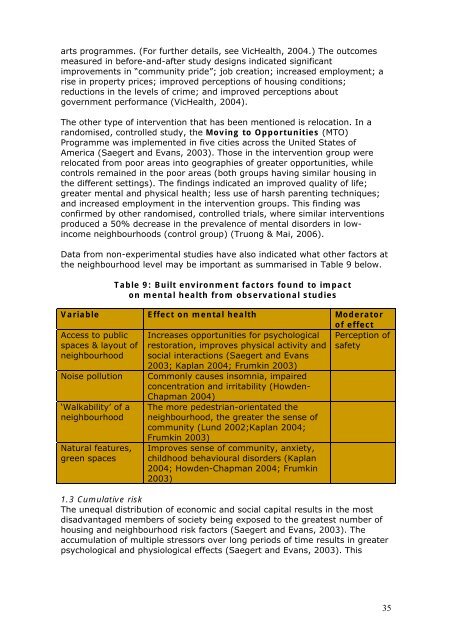(Volume 4) - Mental Health Disorders - Vula - University of Cape Town
(Volume 4) - Mental Health Disorders - Vula - University of Cape Town
(Volume 4) - Mental Health Disorders - Vula - University of Cape Town
You also want an ePaper? Increase the reach of your titles
YUMPU automatically turns print PDFs into web optimized ePapers that Google loves.
arts programmes. (For further details, see Vic<strong>Health</strong>, 2004.) The outcomesmeasured in before-and-after study designs indicated significantimprovements in “community pride”; job creation; increased employment; arise in property prices; improved perceptions <strong>of</strong> housing conditions;reductions in the levels <strong>of</strong> crime; and improved perceptions aboutgovernment performance (Vic<strong>Health</strong>, 2004).The other type <strong>of</strong> intervention that has been mentioned is relocation. In arandomised, controlled study, the Moving to Opportunities (MTO)Programme was implemented in five cities across the United States <strong>of</strong>America (Saegert and Evans, 2003). Those in the intervention group wererelocated from poor areas into geographies <strong>of</strong> greater opportunities, whilecontrols remained in the poor areas (both groups having similar housing inthe different settings). The findings indicated an improved quality <strong>of</strong> life;greater mental and physical health; less use <strong>of</strong> harsh parenting techniques;and increased employment in the intervention groups. This finding wasconfirmed by other randomised, controlled trials, where similar interventionsproduced a 50% decrease in the prevalence <strong>of</strong> mental disorders in lowincomeneighbourhoods (control group) (Truong & Mai, 2006).Data from non-experimental studies have also indicated what other factors atthe neighbourhood level may be important as summarised in Table 9 below.Table 9: Built environment factors found to impacton mental health from observational studiesVariable Effect on mental health Moderator<strong>of</strong> effectAccess to publicspaces & layout <strong>of</strong>Increases opportunities for psychologicalrestoration, improves physical activity andPerception <strong>of</strong>safetyneighbourhood social interactions (Saegert and Evans2003; Kaplan 2004; Frumkin 2003)Noise pollution Commonly causes insomnia, impairedconcentration and irritability (Howden-Chapman 2004)‘Walkability’ <strong>of</strong> aneighbourhoodNatural features,green spacesThe more pedestrian-orientated theneighbourhood, the greater the sense <strong>of</strong>community (Lund 2002;Kaplan 2004;Frumkin 2003)Improves sense <strong>of</strong> community, anxiety,childhood behavioural disorders (Kaplan2004; Howden-Chapman 2004; Frumkin2003)1.3 Cumulative riskThe unequal distribution <strong>of</strong> economic and social capital results in the mostdisadvantaged members <strong>of</strong> society being exposed to the greatest number <strong>of</strong>housing and neighbourhood risk factors (Saegert and Evans, 2003). Theaccumulation <strong>of</strong> multiple stressors over long periods <strong>of</strong> time results in greaterpsychological and physiological effects (Saegert and Evans, 2003). This35

















